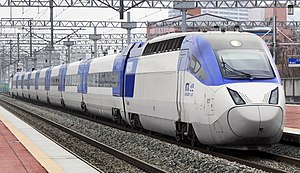Our website is made possible by displaying online advertisements to our visitors.
Please consider supporting us by disabling your ad blocker.
KTX-Sancheon
| KTX-Sancheon | |
|---|---|
 KTX-Sancheon class 110000 | |
 First class interior of class 110000 | |
| Manufacturer | Hyundai Rotem |
| Designer | MBD Design[1][2] |
| Family name | KTX |
| Constructed | 2008–2017 |
| Entered service | 2010 |
| Number built | 71
|
| Number in service | 70
|
| Formation | PC+8T+PC[3]
|
| Capacity |
|
| Operators | Korail, SR |
| Depots | Goyang, Osong |
| Lines served | Gyeongbu high-speed railway Honam high-speed railway Suseo-Pyeongtaek high-speed railway Gyeongbu Line Honam Line Gyeongjeon Line Jeolla Line Donghae Line AREX (until 2018) Gyeonggang Line (until 2021) |
| Specifications | |
| Car body construction | |
| Train length | 201 m (659 ft 5 in)[8][4][5][6] |
| Car length | |
| Width | |
| Height | |
| Floor height | 1,125 mm (44.3 in) |
| Maximum speed | |
| Weight |
|
| Axle load | 17 t (17 long tons; 19 short tons)[7] |
| Traction system | 8 three-phase asynchronous induction motors 4 IGBT-based VVVF inverters |
| Power output | 8 x 1,100 kW (1,500 hp) (8.8 MW or 11,800 hp)[8][11] |
| Tractive effort | 210 kN (47,000 lbf)[7] |
| Acceleration | |
| Deceleration | |
| Auxiliaries | 2 x 1.0 MW (1,341 hp), supplying 670 V DC IGBT-based[14] |
| Power supply | catenary |
| Electric system(s) | 25 kV/60 Hz AC |
| Current collector(s) | pantograph (type: single-arm, SSS400+)[15] |
| UIC classification | Bo'Bo' + 2'(2)(2)(2)(2)(2)(2)(2)2' + Bo'Bo' |
| Braking system(s) | eddy current, regenerative, rheostatic, disc |
| Safety system(s) | ATS, ATP (Ansaldo), TVM-430 |
| Coupling system | Scharfenberg |
| Multiple working | Yes |
| Track gauge | 1,435 mm (4 ft 8+1⁄2 in) standard gauge |
The KTX-Sancheon (Korean: KTX-산천; Hanja: KTX-山川 formerly called the KTX-II) is a South Korean high-speed train built by Hyundai Rotem in the second half of the 2000s and operated by Korail since March 2010. With a top speed of 305 km/h (189.5 mph), the KTX-Sancheon is the second commercial high-speed train operated in South Korea and the first domestic high-speed train that is designed and developed in South Korea.

- ^ "L'Observeur du design 2008 à la Cité des sciences et de l'industrie". Observeur du design 08. Archived from the original on 1 March 2024. Retrieved 14 January 2025.
- ^ "KTX-II TGV". Archived from the original on 14 January 2025. Retrieved 14 January 2025.
- ^ Cite error: The named reference
plans2010was invoked but never defined (see the help page). - ^ a b c d e f g "홍보센터 > 기차소개 > 고속열차 > KTX-산천 - 한국철도공사". Korail (in Korean). Archived from the original on 23 December 2024. Retrieved 14 January 2025.
- ^ a b c d e f "Overview | Overview < SRT < 영문홈페이지 - SR". Super Rapid Train. Archived from the original on 27 December 2024. Retrieved 14 January 2025.
- ^ a b c d e f g "홍보센터 > 기차소개 > 고속열차 > KTX-산천(원강) - 한국철도공사". Korail (in Korean). Archived from the original on 14 January 2025. Retrieved 14 January 2025.
- ^ a b c d "2016/17 Policy Consultation III: Implementation Plan for Construction of High-Speed Railway Infrastructure in Myanmar" (PDF). Archived from the original (PDF) on 14 January 2025. Retrieved 14 January 2025.
- ^ a b c d e Cite error: The named reference
Rotem-pdfwas invoked but never defined (see the help page). - ^ a b c d "KORAIL high speed train (KTX-II)". Hyundai Rotem. Archived from the original on 14 December 2009. Retrieved 23 January 2025.
- ^ a b c d e f Cite error: The named reference
myktx-elwas invoked but never defined (see the help page). - ^ a b "최고시험속도 400km/h 동력분산식 차세대 고속열차 개발(HEMU-400X)". Korean Rail Technology (in Korean). January–February 2009. Archived from the original on 2011-07-21. Retrieved 2011-03-13.
- ^ Cite error: The named reference
5yearswas invoked but never defined (see the help page). - ^ "KTX의 길이, 중량, 편의시설은 어떻게 되나요?". Korail. Archived from the original on 2011-07-22. Retrieved 2010-11-07.
- ^ "KTX-II" (PDF) (in Korean). Rotem. Archived from the original (PDF) on 2011-07-22. Retrieved 2010-11-19.
- ^ Cite error: The named reference
pantowas invoked but never defined (see the help page).
Previous Page Next Page


